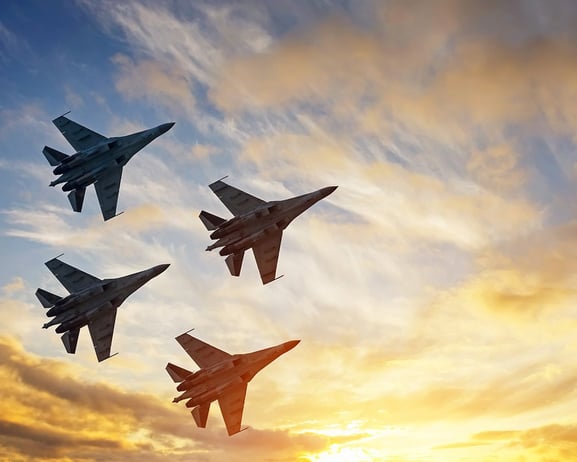Which Countries Have the Best Fighter Jets in 2025?
TRENDING


In the fast-evolving world of military aviation, fighter jets represent the pinnacle of technology, strategy, and national power. From stealth capabilities to cutting-edge avionics, modern jets are designed for air superiority, precision strikes, and versatility in complex battlefields. But which countries lead the pack in 2025? Let’s explore the top contenders, their flagship aircraft, and what makes them stand out.
The United States: The Undisputed Leader
The United States dominates the skies with its fifth-generation fighters: the F-22 Raptor and F-35 Lightning II. These jets set the global standard for performance, stealth, and combat effectiveness.
F-22 Raptor: Designed for air superiority, the F-22 is a stealth masterpiece. Its supercruise capability (sustained supersonic flight without afterburners), advanced radar-evading design, and unmatched maneuverability make it a nightmare for adversaries. With over 180 units built, the F-22 has seen combat in Syria, proving its real-world prowess.
F-35 Lightning II: A multirole marvel, the F-35 excels in air-to-air combat, ground attacks, and intelligence gathering. Its sensor fusion integrates data from multiple sources, giving pilots unparalleled situational awareness. With over 600 units (across variants) in service, the F-35’s global reach and versatility are unmatched.
The U.S. benefits from a massive fleet, extensive combat experience, and a global network of bases. No other nation matches this scale or technological edge.
China: The Rising Power
China’s rapid advancements in military aviation have positioned it as a serious contender. The J-20 Chengdu, a fifth-generation stealth fighter, is the cornerstone of its air force.
J-20 Chengdu: Designed for air superiority and precision strikes, the J-20 boasts advanced avionics, long-range missiles (like the PL-15), and potential supercruise capabilities. With an estimated 200+ units in service, China’s production rate is impressive. While untested in combat, the J-20’s stealth and sensor suite make it a formidable rival.
J-35: A lighter, carrier-based stealth fighter in development, the J-35 signals China’s ambition to dominate naval aviation.
China’s focus on quantity, coupled with technological leaps, makes it a growing threat, though its jets lack the combat experience of U.S. counterparts.
Russia: Power with Limitations
Russia’s Su-57 Felon is its entry into the fifth-generation club, but production and development challenges limit its impact.
Su-57 Felon: Featuring stealth, supermaneuverability, and advanced sensors, the Su-57 aims to compete with the F-22 and J-20. However, its stealth capabilities are debated as inferior, and production is low, with fewer than 20 operational units. Sanctions and economic constraints further hamper Russia’s ability to scale up.
Su-35S: A 4.5-generation fighter, the Su-35S is highly capable, with thrust-vectoring engines and long-range engagement. It’s a workhorse for Russia but lacks true stealth.
The Su-57’s potential is undeniable, but Russia’s limited fleet and lack of combat testing keep it behind the U.S. and China.
Europe: Excellence in 4.5-Generation Fighters
European nations like France, the UK, and Germany field advanced 4.5-generation jets, but they lag in fifth-generation platforms.
France - Rafale: The Dassault Rafale is a multirole fighter with advanced radar (AESA), electronic warfare systems, and a proven combat record in Libya and Syria. Its versatility across air, land, and sea missions is remarkable, but it lacks stealth.
UK, Germany, and Others - Eurofighter Typhoon: The Typhoon excels in air-to-air combat, with superb agility and avionics. Widely used across Europe, it’s a cornerstone of NATO air forces but, like the Rafale, isn’t a fifth-generation stealth platform.
Europe is investing in future projects like FCAS (France, Germany, Spain) and Tempest (UK, Italy, Japan), aiming for sixth-generation jets with AI and drone-swarming capabilities by the 2030s.
India: Emerging but Behind
India’s air force combines indigenous and imported jets, but it trails in fifth-generation technology.
Tejas Mk1A: India’s homegrown light combat aircraft is a 4.5-generation fighter with modern avionics and agility. It’s a step forward but not on par with global leaders.
Su-30 MKI: A Russian-origin 4.5-generation jet, the Su-30 MKI is a multirole heavyweight with strong performance. However, it lacks stealth.
AMCA: India’s Advanced Medium Combat Aircraft, a fifth-generation project, is still in the prototype phase, with operational deployment years away.
India’s reliance on older platforms and slow indigenous development limits its standing for now.
What Makes a Fighter Jet the "Best"?
Several factors define a top-tier fighter jet in 2025:
Stealth: Fifth-generation jets (F-22, F-35, J-20, Su-57) use radar-evading designs, critical for surviving modern air defenses.
Sensor Fusion: Advanced avionics integrate data from radar, satellites, and other sources for superior situational awareness.
Combat Experience: U.S. jets have proven themselves in real conflicts, unlike China’s J-20 or Russia’s Su-57.
Numbers and Logistics: Large fleets and global basing (U.S.) ensure operational dominance, while smaller fleets (Russia) limit impact.
Future Tech: Sixth-generation concepts, like AI integration and drone-swarming, are shaping the next frontier.
The Future of Fighter Jets
The race for air superiority is heating up. China’s aggressive production and Europe’s sixth-generation projects signal a shift in the balance of power. Meanwhile, the U.S. is exploring next-generation platforms like the NGAD (Next Generation Air Dominance) program, which promises revolutionary capabilities.
Conclusion
In 2025, the United States leads with the F-22 and F-35, combining unmatched technology, numbers, and combat experience. China’s J-20 is a rising star, with potential to challenge U.S. dominance as its fleet grows. Russia’s Su-57, while advanced, is constrained by production issues. Europe and India field capable 4.5-generation jets but lag in stealth technology. As the skies evolve, the race for the ultimate fighter jet remains a thrilling saga of innovation and strategy.